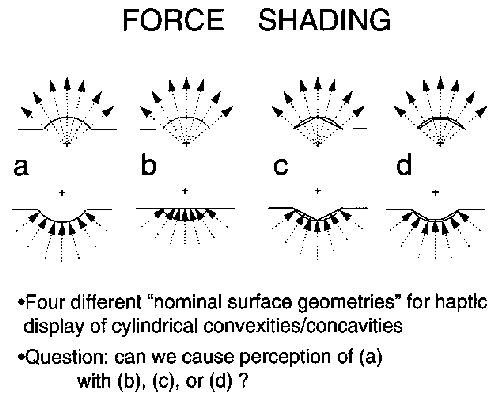
 |
|||||||
Software Tools for Simulated Worlds |
|
We have developed novel algorithms for the haptic display of shape, texture and friction of solid surfaces using the PHANToM (Morgenbesser and Srinivasan, 1996). We have also performed psychophysical experiments to determine the effectiveness of such rendering algorithms in conveying the desired object properties to the human user. The results show that even when the user is exploring nominally flat surfaces, he can be made to feel as if he is interacting with a shaped and textured surface by appropriately varying the direction of the force reflected back to the user. These new algorithms, called "Force Shading," permit the mapping of a shape or texture onto a polygon, so that they may be used in haptic rendering in the same way that texture mapping and color shading are used in graphics rendering.  We have performed psychophysical experiments to determine the simplest polyhedral representation that is acceptable to the user as a smooth continuous surface. The PHANToM, which is a high performance haptic interface device developed as a part of the VETT project, was utilized for the experiments. It is capable of reflecting back 3-dimensional force vectors within a 3-dimensional workspace. In the first set of experiments, in each trial, the user is asked to stroke the stylus of the PHANToM over a continuous cylindrical surface and a polyhedral approximation to it (both are virtual surfaces). The polyhedral surface is associated with a force-shading scheme such that the subject can vary the effective average curvature of the polyhedral surface. The subject is asked to modify the force-shaded polyhedron until it perceptually matches the feel of the continuum surface. These experiments have been conducted for polyhedra with one to three faces approximating cylinders of several radii of curvature. The results show that the force-shading algorithm is successful in creating the illusion of a continuous surface and that the polyhedral surface needs to have a higher average curvature than that of the continuous cylinder that is its perceptual equivalent.
|
|
|
|
Click here to read more about HaptiC-Binder. |
| Last Updated: May 8, 2002 1:45 PM | Comments: David Schloerb |